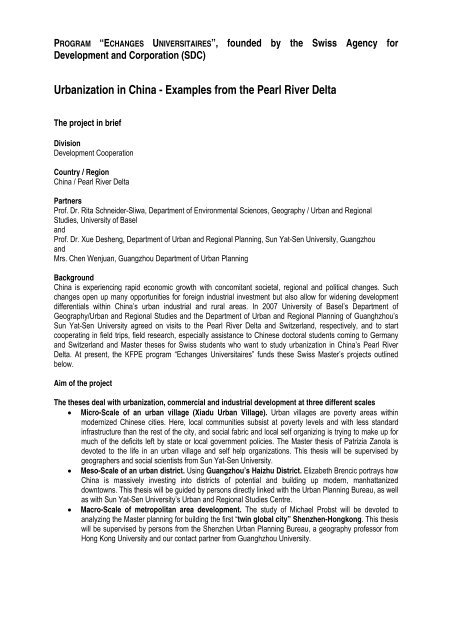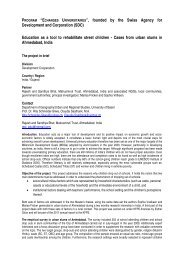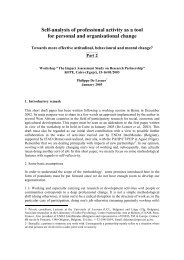Urbanization in China - Examples from the Pearl River Delta - KFPE
Urbanization in China - Examples from the Pearl River Delta - KFPE
Urbanization in China - Examples from the Pearl River Delta - KFPE
You also want an ePaper? Increase the reach of your titles
YUMPU automatically turns print PDFs into web optimized ePapers that Google loves.
PROGRAM “ECHANGES UNIVERSITAIRES”, founded by <strong>the</strong> Swiss Agency for<br />
Development and Corporation (SDC)<br />
<strong>Urbanization</strong> <strong>in</strong> Ch<strong>in</strong>a - <strong>Examples</strong> <strong>from</strong> <strong>the</strong> <strong>Pearl</strong> <strong>River</strong> <strong>Delta</strong><br />
The project <strong>in</strong> brief<br />
Division<br />
Development Cooperation<br />
Country / Region<br />
Ch<strong>in</strong>a / <strong>Pearl</strong> <strong>River</strong> <strong>Delta</strong><br />
Partners<br />
Prof. Dr. Rita Schneider-Sliwa, Department of Environmental Sciences, Geography / Urban and Regional<br />
Studies, University of Basel<br />
and<br />
Prof. Dr. Xue Desheng, Department of Urban and Regional Plann<strong>in</strong>g, Sun Yat-Sen University, Guangzhou<br />
and<br />
Mrs. Chen Wenjuan, Guangzhou Department of Urban Plann<strong>in</strong>g<br />
Background<br />
Ch<strong>in</strong>a is experienc<strong>in</strong>g rapid economic growth with concomitant societal, regional and political changes. Such<br />
changes open up many opportunities for foreign <strong>in</strong>dustrial <strong>in</strong>vestment but also allow for widen<strong>in</strong>g development<br />
differentials with<strong>in</strong> Ch<strong>in</strong>a’s urban <strong>in</strong>dustrial and rural areas. In 2007 University of Basel’s Department of<br />
Geography/Urban and Regional Studies and <strong>the</strong> Department of Urban and Regional Plann<strong>in</strong>g of Guanghzhou’s<br />
Sun Yat-Sen University agreed on visits to <strong>the</strong> <strong>Pearl</strong> <strong>River</strong> <strong>Delta</strong> and Switzerland, respectively, and to start<br />
cooperat<strong>in</strong>g <strong>in</strong> field trips, field research, especially assistance to Ch<strong>in</strong>ese doctoral students com<strong>in</strong>g to Germany<br />
and Switzerland and Master <strong>the</strong>ses for Swiss students who want to study urbanization <strong>in</strong> Ch<strong>in</strong>a’s <strong>Pearl</strong> <strong>River</strong><br />
<strong>Delta</strong>. At present, <strong>the</strong> <strong>KFPE</strong> program “Echanges Universitaires” funds <strong>the</strong>se Swiss Master’s projects outl<strong>in</strong>ed<br />
below.<br />
Aim of <strong>the</strong> project<br />
The <strong>the</strong>ses deal with urbanization, commercial and <strong>in</strong>dustrial development at three different scales<br />
• Micro-Scale of an urban village (Xiadu Urban Village). Urban villages are poverty areas with<strong>in</strong><br />
modernized Ch<strong>in</strong>ese cities. Here, local communities subsist at poverty levels and with less standard<br />
<strong>in</strong>frastructure than <strong>the</strong> rest of <strong>the</strong> city, and social fabric and local self organiz<strong>in</strong>g is try<strong>in</strong>g to make up for<br />
much of <strong>the</strong> deficits left by state or local government policies. The Master <strong>the</strong>sis of Patrizia Zanola is<br />
devoted to <strong>the</strong> life <strong>in</strong> an urban village and self help organizations. This <strong>the</strong>sis will be supervised by<br />
geographers and social scientists <strong>from</strong> Sun Yat-Sen University.<br />
• Meso-Scale of an urban district. Us<strong>in</strong>g Guangzhou’s Haizhu District. Elizabeth Brencic portrays how<br />
Ch<strong>in</strong>a is massively <strong>in</strong>vest<strong>in</strong>g <strong>in</strong>to districts of potential and build<strong>in</strong>g up modern, manhattanized<br />
downtowns. This <strong>the</strong>sis will be guided by persons directly l<strong>in</strong>ked with <strong>the</strong> Urban Plann<strong>in</strong>g Bureau, as well<br />
as with Sun Yat-Sen University’s Urban and Regional Studies Centre.<br />
• Macro-Scale of metropolitan area development. The study of Michael Probst will be devoted to<br />
analyz<strong>in</strong>g <strong>the</strong> Master plann<strong>in</strong>g for build<strong>in</strong>g <strong>the</strong> first “tw<strong>in</strong> global city” Shenzhen-Hongkong. This <strong>the</strong>sis<br />
will be supervised by persons <strong>from</strong> <strong>the</strong> Shenzhen Urban Plann<strong>in</strong>g Bureau, a geography professor <strong>from</strong><br />
Hong Kong University and our contact partner <strong>from</strong> Guanghzhou University.
Project target<br />
Promotion of cross-cultural learn<strong>in</strong>g and research <strong>in</strong> urban development plann<strong>in</strong>g. Foster<strong>in</strong>g research skills of<br />
young Swiss professionals <strong>in</strong> <strong>in</strong>ternational contexts of Swiss national <strong>in</strong>terest.<br />
Target group<br />
Young professionals work<strong>in</strong>g <strong>in</strong> <strong>in</strong>ternational urban development; <strong>in</strong>ternational urban plann<strong>in</strong>g community.<br />
Duration<br />
April 2009 to April 2010<br />
Contact<br />
Department of Geography/Urban and Regional Studies, University of Basel<br />
Prof. Dr. Rita Schneider-Sliwa, Claudia Saalfrank, M.A.<br />
Rita.Schneider-Sliwa@unibas.ch, Claudia.Saalfrank@unibas.ch<br />
Department of Urban and Regional Plann<strong>in</strong>g, School of Geographical Science and Plann<strong>in</strong>g (SGSP),<br />
Sun Yat-Sen University<br />
Prof. XUE Desheng<br />
Guangzhou, Guangdong, Ch<strong>in</strong>a, 510275<br />
eesxds@mail.sysu.edu.cn<br />
Details of <strong>the</strong> Masters <strong>the</strong>ses<br />
4.1 Social organization <strong>in</strong> Urban Villages <strong>in</strong> <strong>the</strong> <strong>Pearl</strong> <strong>River</strong> <strong>Delta</strong>, South Ch<strong>in</strong>a. The case of Xiadu Village.<br />
Master <strong>the</strong>sis by Patrizia Zanola <strong>in</strong> cooperation with Prof. Dr. Xue Desheng, Chairman Sun Yatsen University,<br />
Department of Urban and Regional Plann<strong>in</strong>g with Prof. Dr. Li Zhigang and Prof. Dr. Rita Schneider-Sliwa<br />
Objective. The study underly<strong>in</strong>g this paper aims to <strong>in</strong>vestigate <strong>the</strong> impact of urbanization on <strong>the</strong> <strong>in</strong>habitants of<br />
urban villages, <strong>the</strong>ir state and condition and also <strong>the</strong>ir needs and wishes; and this on a micro level. The results of<br />
<strong>the</strong> study are meant to give an idea about <strong>the</strong> <strong>in</strong>habitants’ needs, and how <strong>the</strong>y organize <strong>the</strong>mselves to meet<br />
<strong>the</strong>se needs. Moreover, <strong>the</strong> study is <strong>in</strong>tended to be a small contribution to current research <strong>in</strong> urbanization and<br />
especially urban villages <strong>in</strong> Guangdong Prov<strong>in</strong>ce.<br />
Xiadu urban village: Harsh contrasts as Waste disposal <strong>in</strong> Xiadu village Small lane <strong>in</strong> <strong>the</strong> old part of Xiadu<br />
a consequence of urbanisation <strong>in</strong> Guangzhou<br />
Ma<strong>in</strong> Research Questions of <strong>the</strong> paper:<br />
• In what ways has urban plann<strong>in</strong>g affected <strong>the</strong> village and its <strong>in</strong>habitants?<br />
• How were <strong>the</strong> villagers and urban villages organized before <strong>the</strong>y were surrounded by <strong>the</strong> city?<br />
• How do <strong>the</strong> villagers organize <strong>the</strong>mselves <strong>in</strong> terms of:<br />
- Health care?<br />
- Economics (<strong>in</strong>come, expenses etc.)?<br />
- Family structures?<br />
- Education?<br />
- Food and o<strong>the</strong>r necessities supply?
- Political structures?<br />
• What is <strong>the</strong>ir liv<strong>in</strong>g condition like if compared to o<strong>the</strong>r citizens and what is <strong>the</strong> position of official urban<br />
plann<strong>in</strong>g/city adm<strong>in</strong>istration?<br />
• What are <strong>the</strong> urban villagers’ needs and wishes for <strong>the</strong> future and what is <strong>the</strong> role of official urban<br />
plann<strong>in</strong>g?<br />
With <strong>the</strong>se research questions <strong>in</strong> m<strong>in</strong>d it is <strong>the</strong> ma<strong>in</strong> aim of <strong>the</strong> paper to outl<strong>in</strong>e <strong>the</strong> current situation of <strong>the</strong><br />
<strong>in</strong>habitants of Xiadu Village <strong>in</strong> Guangzhou, close to <strong>the</strong> Sun Yat-Sen University Ma<strong>in</strong> Campus. On <strong>the</strong> basis of<br />
this analysis it is <strong>in</strong>tended to identify central issues. The focus of <strong>the</strong> paper ma<strong>in</strong>ly lies <strong>in</strong> three po<strong>in</strong>ts: current<br />
state, challenges and perspectives of urban villages.<br />
Relevance. The <strong>in</strong>terest of scholars <strong>in</strong> urban villages and o<strong>the</strong>r manifestations of urbanization has lately grown all<br />
over <strong>the</strong> globe. One of <strong>the</strong> reasons is certa<strong>in</strong>ly that urbanization is tak<strong>in</strong>g place everywhere, and that it is of great<br />
<strong>in</strong>terest how it proceeds and which challenges it br<strong>in</strong>gs along for society, politics, economy and environment. The<br />
<strong>in</strong>vestigation of present conditions can give important <strong>in</strong>formation about future developments and how <strong>the</strong>y<br />
should be met. Therefore, it is necessary to exam<strong>in</strong>e <strong>the</strong>se phenomena as soon as <strong>the</strong>y emerge and try to<br />
supervise <strong>the</strong>m <strong>in</strong> order to be able to make predictions. Moreover, this topic is of importance s<strong>in</strong>ce urban villages<br />
are seen as a problematic issue <strong>in</strong> <strong>the</strong> context of Ch<strong>in</strong>a and hence also constitute challenges for urban plann<strong>in</strong>g.<br />
It is necessary to carry out studies on a micro level to assist and accompany urban plann<strong>in</strong>g efforts. A fur<strong>the</strong>r<br />
po<strong>in</strong>t will be an analysis of <strong>the</strong> transferability of <strong>the</strong>se suggestions <strong>in</strong> order to see whe<strong>the</strong>r <strong>the</strong> f<strong>in</strong>d<strong>in</strong>gs can be<br />
applied to o<strong>the</strong>r examples or not.<br />
4.2 The Modern Model of Urban Plann<strong>in</strong>g <strong>in</strong> Guangzhou. The case of Guangzhou’s Haizhu District.<br />
Master <strong>the</strong>sis by Elizabeth Brencic <strong>in</strong> cooperation with Prof. Dr. Xue Desheng Sun Yatsen University, Department<br />
of Urban and Regional Plann<strong>in</strong>g and Mrs. Chen Wenjuan, Guanghzou Department of Urban Plann<strong>in</strong>g, Haizhu<br />
District Plann<strong>in</strong>g and Prof. Dr. Rita Schneider-Sliwa, University of Basel, Geography/Urban and Regional Studies<br />
Objective. The aim of this Master <strong>the</strong>sis is to <strong>in</strong>vestigate and document how Guangzhou ga<strong>in</strong>ed knowledge of<br />
o<strong>the</strong>r countries as how to construct a new, modern Haizhu District and thus to avoid problems that have occurred<br />
<strong>in</strong> <strong>the</strong> past of Western urban plann<strong>in</strong>g. The Guangzhou/Haizhu District plann<strong>in</strong>g is used as a (best practice)<br />
model of urban plann<strong>in</strong>g which can prove to be <strong>in</strong>terest<strong>in</strong>g and <strong>in</strong>structive for fur<strong>the</strong>r urban plann<strong>in</strong>g models. This<br />
study is <strong>in</strong>tended to be a contribution to current research <strong>in</strong> urbanization and <strong>in</strong>ternational urban plann<strong>in</strong>g by<br />
us<strong>in</strong>g Guangzhou’s Haizhu district as an example.<br />
Map of Datang affordable hous<strong>in</strong>g community with Dong Feng village, Jude Garden<br />
and o<strong>the</strong>r villages under construction.<br />
High rise build<strong>in</strong>gs <strong>in</strong> Jude<br />
Garden<br />
Ma<strong>in</strong> Research Questions of <strong>the</strong> paper:<br />
• What aims have been set for <strong>the</strong> construction of Guangzhou's Haizhu District? What are <strong>the</strong> details of<br />
<strong>the</strong> Master Plan?<br />
• How is district plann<strong>in</strong>g decided upon?<br />
• Which Western models – or o<strong>the</strong>rs – were adapted (if at all) <strong>in</strong> <strong>the</strong> plann<strong>in</strong>g of Guangzhou's Haizhu<br />
District? Why? Which types of Western models have served as best/worst practice cases for<br />
Guangzhou’s Urban Plann<strong>in</strong>g Department?
• How will traffic problems, lack of green areas or <strong>in</strong>sufficient public facilities be reduced? What are <strong>the</strong><br />
solutions to create a well-operat<strong>in</strong>g <strong>in</strong>ternational metropolis?<br />
• How does this process work politically? How does urban plann<strong>in</strong>g <strong>in</strong> Guangzhou get legitimized?<br />
With <strong>the</strong>se research questions <strong>in</strong> m<strong>in</strong>d it is <strong>the</strong> ma<strong>in</strong> aim of <strong>the</strong> paper to outl<strong>in</strong>e <strong>the</strong> development of Guangzhou’s<br />
Haizhu District. The focus of <strong>the</strong> paper ma<strong>in</strong>ly lies <strong>in</strong> three po<strong>in</strong>ts: current state, challenges and perspectives of<br />
Giangzhou's Haizhu District.<br />
Relevance. <strong>Urbanization</strong> and <strong>in</strong>dustrialization are both topics that are of Ch<strong>in</strong>a’s daily focus. Urban plann<strong>in</strong>g is of<br />
high importance <strong>in</strong> admir<strong>in</strong>g general goals of economic growth development. A ma<strong>in</strong> issue is to develop areas <strong>in</strong><br />
order to make humans, nature and development profit better <strong>from</strong> <strong>the</strong> given space. This study will shed light at a<br />
best practice approach us<strong>in</strong>g <strong>the</strong> Haizhu District as an example.<br />
4.3 Metropolitan Plann<strong>in</strong>g for a Global Tw<strong>in</strong> City: The Case of Hong Kong – Shenzhen.<br />
Master <strong>the</strong>sis by Michael Probst <strong>in</strong> cooperation with Prof. Dr. Xue Desheng, Chairman Sun Yatsen University,<br />
Department of Urban and Regional Plann<strong>in</strong>g with Michael Men, Shenzhen Urban Plann<strong>in</strong>g Department and Prof.<br />
Dr. Rita Schneider-Sliwa<br />
Objective. This <strong>the</strong>sis analyzes <strong>the</strong> urban and metropolitan plann<strong>in</strong>g concepts for <strong>the</strong> tw<strong>in</strong> metropolis of Hong<br />
Kong – Shenzhen. The follow<strong>in</strong>g questions will be addressed:<br />
● How does <strong>the</strong> Master Plan ‘plan’ for <strong>the</strong> global tw<strong>in</strong> city?<br />
● How are <strong>the</strong> sectoral plans for traffic, communication, energy, water supply etc. structured to achieve <strong>the</strong> aim of<br />
<strong>in</strong>tegrat<strong>in</strong>g <strong>the</strong> two cities to become one large (tw<strong>in</strong>) megacity?<br />
● What ma<strong>in</strong> l<strong>in</strong>ks and structures (traffic, communication, energy, water supply etc.) already exist between Hong<br />
Kong and Shenzhen; how will <strong>the</strong>y be <strong>in</strong>tegrated?<br />
● How does <strong>the</strong> zon<strong>in</strong>g plan structure for future commercial, <strong>in</strong>dustrial and high-tech economic development and<br />
related population growth, hous<strong>in</strong>g, job and recreational needs?<br />
● How do Special Area Plans fit <strong>in</strong>? Where are <strong>the</strong> areas of expansion?<br />
● Will new structures replace old ones (structures will be pulled down)? What are <strong>the</strong> plans for relocat<strong>in</strong>g (old)<br />
<strong>in</strong>dustries, commerce and people? What are <strong>the</strong> time frames of such plans?<br />
● What will <strong>the</strong> ma<strong>in</strong> challenges be regard<strong>in</strong>g <strong>the</strong> metropolitan area plann<strong>in</strong>g for <strong>the</strong> global tw<strong>in</strong> city? What are<br />
some solutions?<br />
● Who are <strong>the</strong> actors (<strong>in</strong>vestors, planners and architects; developers)? Does Foreign Direct Investment (FDI)<br />
play a major role?<br />
● How and to what extent is <strong>the</strong> state, private enterprise or public-private partnerships <strong>in</strong>volved <strong>in</strong> plann<strong>in</strong>g,<br />
<strong>in</strong>vestment and build<strong>in</strong>g?<br />
● What role does <strong>the</strong> empty space play between Shenzhen and Hong Kong (particularly <strong>the</strong> Nor<strong>the</strong>rn<br />
Territories)? What role do <strong>the</strong> marshlands, natural reserves and present New Towns (ex. T<strong>in</strong> Shui Wai) play <strong>in</strong><br />
this? What role does <strong>the</strong> nor<strong>the</strong>rn h<strong>in</strong>terland of Shenzhen play <strong>in</strong> <strong>the</strong> relocation of dirty <strong>in</strong>dustries <strong>from</strong><br />
Shenzhen which want to turn <strong>the</strong>ir image <strong>from</strong> an <strong>in</strong>dustrial production site (work bench of <strong>the</strong> world) to a<br />
modern high-tech metropolis?<br />
City Hall of Shenzhen<br />
Shenzhen<br />
Relevance. The Shenzhen – Hong Kong Metropolitan Area is currently <strong>the</strong> only region <strong>in</strong> <strong>the</strong> world where a<br />
global tw<strong>in</strong> city is actually be<strong>in</strong>g planned. Given <strong>the</strong> massive focus on rapid urbanization <strong>in</strong> <strong>the</strong> PRD of Ch<strong>in</strong>a and
given <strong>the</strong> means of both <strong>the</strong> state and private enterprise levels, <strong>the</strong> means to achieve such ambitious goals exist.<br />
Ch<strong>in</strong>a has extensive experience to plan and create megacities for millions of <strong>in</strong>habitants. Ch<strong>in</strong>a and Ch<strong>in</strong>ese<br />
planners are also tak<strong>in</strong>g active <strong>in</strong>terest <strong>in</strong> study<strong>in</strong>g and achiev<strong>in</strong>g foreign experience with urban concepts <strong>from</strong><br />
o<strong>the</strong>r countries. As such, <strong>the</strong> way <strong>the</strong> global tw<strong>in</strong> city of Hong Kong – Shenzhen is be<strong>in</strong>g approached, proves to<br />
be an <strong>in</strong>ternational new model of urbanization <strong>from</strong> which both Ch<strong>in</strong>a and Western countries can learn.





